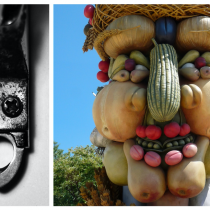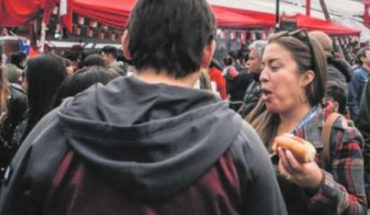
In 1995 the American painter William Utermohlen was diagnosed with Alzheimer’s at the age of 62. However, from that date, and until about 2000, he developed an artistic work that consisted of painting a series of self-portraits. During that period, and as time progressed, the inevitable progression of the neurodegenerative disorder that affected him was evident in his art, reflected, for example, in the difficulties in recognizing and drawing his own face, replacing it with increasingly amorphous strokes.
The series of paintings made by Utermohlen has been the subject of study in various medical and psychological research groups, which try to give answers to certain neural alterations and their relationship with problems in facial recognition, such as those presented by the artist.
In this sense, and to complement research in this regard, some more current studies have focused on another curious perceptual experience called facial pareidolia, which can be defined as the illusory phenomenon of seeing structures similar to a face, but in everyday objects. Pareidolia originates when sensory information is processed by certain visual mechanisms specialized in obtaining the content present in the faces, for example, those evoked in the expressions of happiness, anger, attention, surprise, etc.
The fact of seeing patterns or connections in random events (without a necessary causality) is an ability exhibited by human beings, as when we describe figures in clouds or forms associated with constellations, a process in which our brain assigns meaning to accidental figures. Therefore, facial pareidolia is a variant of this perceptual phenomenon, but, as its name says, it is focused exclusively on the identification of that section of the body.
This recognition mechanism is generated in a specific sector of the temporal cerebral cortex called the facial fusiform area and has been described both in humans and in other members of the animal kingdom. This phenomenon is attributed a function of natural alarm or warning signal that allows to distinguish, in fractions of a second, familiar faces from the face of a potential predator, or to differentiate other figures from known faces. Consequently, it is an evolutionary adaptation that has effectively favored the survival of many species over the years.
However, in a strictly human sense, facial pareidolia becomes relevant as it is altered in several mental and neurodegenerative disorders, causing interest not only scientifically, but also in other areas of knowledge, which try to portray in their own way the mental alterations of those who suffer from these diseases. To the same Utermohlen, the case of the painter Louis Wain or that of the American writer Charlotte Perkins Gilman is added, who in her famous story “The Yellow Wallpaper” relates the mental development of a young wife.
Pareidolia and mental disorders
Several scientists have reported that the phenomenon of pareidolia is not only altered in Alzheimer’s, but also in Huntington’s disease, Parkinson’s and, to a lesser extent, in Down syndrome. To these are added the studies in schizophrenia, a chronic psychiatric disease, which is characterized by experiencing hallucinations, delusions and having, among other effects, a lower capacity in the understanding of reality. In this regard, a recent research evaluated the ability of schizophrenic people to perceive the phenomenon of facial pareidolia and contrast the results with other individuals who did not suffer from this mental disorder, which were used as a control.
To carry out the study, the team led by Rebecca Rolf of the University of Tübingen (Germany), used paintings with a style very similar to that of the Renaissance painter Giuseppe Arcimboldo, who portrayed human figures or faces with fruits and vegetables. The images in these paintings were presented to 17 people suffering from schizophrenia (13 men and 4 women), who were in medical treatment and had an age range between 27 and 50 years. In the case of the control individuals, they were the same age and sex as the schizophrenic patients with whom they were paired. Thus, the 34 people who made up the study observed 10 images composed of foods that exhibited human facial characteristics in ascending order, that is, the first evo imagesthey had fewer characteristics of human faces than the last ones.
After the assessment of each painting, people were asked to describe what was displayed in a report. In addition, they performed an extra task that consisted of completing the missing pieces of a puzzle of the human face. Finally, all these descriptions were evaluated by experts in the area of facial recognition, who classified what the participants described into: facial or non-facial.
The researchers established that the control individuals began to see human faces between image 2 and 5. On the other hand, about half of those suffering from the mental disorder did so in image 9 or 10. It caused some curiosity in the scientists, that a number of schizophrenic individuals reported seeing faces in the first images, a fact that was resolved with the analyses in the results of the second assigned task, where people with schizophrenia had difficulty spontaneously recognizing the images that evoked content of human faces in the incomplete puzzle.
Thus, the study concluded that this effect was the result of deficiencies in visual perceptual integration and social cognition typical of schizophrenic disorder, ruling out deviations in general cognitive abilities. Consequently, for a person to see a face, he has to establish connections between the various elements to perceive them as a whole, so in the first images the unitary elements that make up the paintings used for this research (fruits and vegetables) do not trigger a facial recognition mechanism by itself.
On the other hand, the study points out certain differences between men and women, which has also been reported in other research, which indicate a certain “neuroprotective” role of female hormones, increasing the prevalence of this type of disorders in men.
Surely there are still many unknowns to be solved in the complex functioning of the human brain, which, in a healthy state, is “programmed” for almost instantaneous facial detection, however, in the future it is not ruled out to use the phenomenon of pareidolia as an early detection mechanism in certain mental and neurodegenerative diseases. It should be noted that an alteration in this system leads to a misinterpretation of social signals that are vital to establish effective interpersonal interactions, where the development of a mechanism to recognize faces is essential for nonverbal communication.
Source:https://www.sciencedirect.com/science/article/abs/pii/S0920996420300359?via%3Dihub
*This article arises from the agreement with the Interdisciplinary Center for Neuroscience of the University of Valparaíso.





